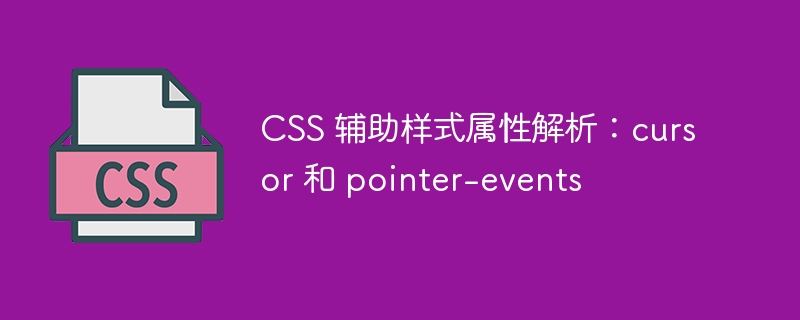CSS auxiliary style attribute parsing: cursor and pointer-events

CSS auxiliary style attribute analysis: cursor and pointer-events
are often encountered in website development Some special requirements need to be implemented through some auxiliary style attributes. cursor and pointer-events are two commonly used style attributes that provide better feedback and control as the user interacts with the page. This article will analyze these two properties in detail and provide specific code examples.
1. cursor Attributes
cursor Attributes are used to define the style of the mouse on an element. By changing the mouse style, we can convey different visual feedback as the user interacts with the page. The following are some commonly used cursor attribute values:
-
auto: Default value, the browser automatically determines the cursor style based on the element type. -
default: Default cursor style. -
pointer: Indicates a clickable link or interactable element. -
move: Indicates clickable and draggable elements. -
text: Indicates an element whose text can be edited. -
not-allowed: Indicates elements that are prohibited from being clicked.
Here is a simple example showing how to use the cursor attribute to change the mouse style:
.button {
cursor: pointer;
}
.link {
cursor: pointer;
}
.text-input {
cursor: text;
}In the above code, .button# The mouse of the ## class and .link class elements will change to a hand shape, indicating that it can be clicked, while the mouse of the .text-input class element will change to a text input cursor, indicating that it can be clicked. Edit text.
pointer-events Attribute
pointer-events The attribute is used to control whether the element can respond to the user's mouse events. By setting different attribute values, we can achieve the clickability and penetrability of elements. The following are some commonly used pointer-events attribute values:
- auto
: Default value, the element can respond to mouse events. - none
: The element cannot respond to mouse events. Mouse events will be received by its parent element or the element below. - visiblePainted
: The element is considered for visual rendering but does not receive mouse events. - visibleFill
: The filled portion of the element is considered in visual rendering, but does not receive mouse events.
pointer-events attribute to control the clickability and penetrability of an element:
The above is the detailed content of CSS auxiliary style attribute parsing: cursor and pointer-events. For more information, please follow other related articles on the PHP Chinese website!

Hot AI Tools

Undresser.AI Undress
AI-powered app for creating realistic nude photos

AI Clothes Remover
Online AI tool for removing clothes from photos.

Undress AI Tool
Undress images for free

Clothoff.io
AI clothes remover

Video Face Swap
Swap faces in any video effortlessly with our completely free AI face swap tool!

Hot Article

Hot Tools

Notepad++7.3.1
Easy-to-use and free code editor

SublimeText3 Chinese version
Chinese version, very easy to use

Zend Studio 13.0.1
Powerful PHP integrated development environment

Dreamweaver CS6
Visual web development tools

SublimeText3 Mac version
God-level code editing software (SublimeText3)

Hot Topics
 1386
1386
 52
52
 Building an Ethereum app using Redwood.js and Fauna
Mar 28, 2025 am 09:18 AM
Building an Ethereum app using Redwood.js and Fauna
Mar 28, 2025 am 09:18 AM
With the recent climb of Bitcoin’s price over 20k $USD, and to it recently breaking 30k, I thought it’s worth taking a deep dive back into creating Ethereum
 Vue 3
Apr 02, 2025 pm 06:32 PM
Vue 3
Apr 02, 2025 pm 06:32 PM
It's out! Congrats to the Vue team for getting it done, I know it was a massive effort and a long time coming. All new docs, as well.
 Can you get valid CSS property values from the browser?
Apr 02, 2025 pm 06:17 PM
Can you get valid CSS property values from the browser?
Apr 02, 2025 pm 06:17 PM
I had someone write in with this very legit question. Lea just blogged about how you can get valid CSS properties themselves from the browser. That's like this.
 A bit on ci/cd
Apr 02, 2025 pm 06:21 PM
A bit on ci/cd
Apr 02, 2025 pm 06:21 PM
I'd say "website" fits better than "mobile app" but I like this framing from Max Lynch:
 Stacked Cards with Sticky Positioning and a Dash of Sass
Apr 03, 2025 am 10:30 AM
Stacked Cards with Sticky Positioning and a Dash of Sass
Apr 03, 2025 am 10:30 AM
The other day, I spotted this particularly lovely bit from Corey Ginnivan’s website where a collection of cards stack on top of one another as you scroll.
 Using Markdown and Localization in the WordPress Block Editor
Apr 02, 2025 am 04:27 AM
Using Markdown and Localization in the WordPress Block Editor
Apr 02, 2025 am 04:27 AM
If we need to show documentation to the user directly in the WordPress editor, what is the best way to do it?
 Comparing Browsers for Responsive Design
Apr 02, 2025 pm 06:25 PM
Comparing Browsers for Responsive Design
Apr 02, 2025 pm 06:25 PM
There are a number of these desktop apps where the goal is showing your site at different dimensions all at the same time. So you can, for example, be writing
 Let's use (X, X, X, X) for talking about specificity
Mar 24, 2025 am 10:37 AM
Let's use (X, X, X, X) for talking about specificity
Mar 24, 2025 am 10:37 AM
I was just chatting with Eric Meyer the other day and I remembered an Eric Meyer story from my formative years. I wrote a blog post about CSS specificity, and




